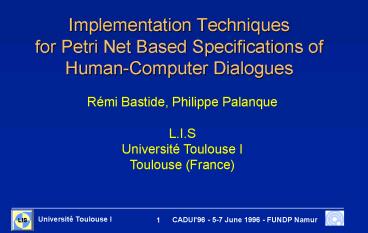Implementation Techniques for Petri Net Based Specifications of HumanComputer Dialogues
1 / 18
Title:
Implementation Techniques for Petri Net Based Specifications of HumanComputer Dialogues
Description:
Each user action must have an immediate feedback ... Automatic code generation. Generation. Transformation. of the OBCS. ObCS of the ICOS. Marking tree ... –
Number of Views:112
Avg rating:3.0/5.0
Title: Implementation Techniques for Petri Net Based Specifications of HumanComputer Dialogues
1
Implementation Techniques for Petri Net Based
Specifications of Human-Computer Dialogues
Rémi Bastide, Philippe Palanque L.I.S Université
Toulouse I Toulouse (France)
2
Goals of the ICO formalism
- Describe the dialogue structure of event-driven
interfaces with high-level Petri nets - Integrate cleanly with current software
engineering practice - UIMS to build the interface
- Object-oriented modelling for the design of the
application
3
From Specification to Implementation
- The specification work must not be thrown away at
the implementation stage. - First option generating code from the
specification - Advantage conventional implementation tools and
languages. - Second option directly interpret the
specification (embedded models) - Advantage rapid prototyping is made easier
- Use the embedded model at run-time, e.g. for
debugging or for providing contextual help
4
Event-driven vs. "hard" reactive systems
- Easier
- No true concurrency, "cooperative multitasking",
no interrupts, critical sections, etc. - Tougher
- The internal state must always be perceptible by
the user - Each user action must have an immediate feedback
5
Why use Petri nets
- State and event on an equal basis
- Structuring mechanisms
- hierarchical refinement (macros)
- composition mechanisms (client-server protocol)
- Easy description of parallelism
- Timed-Petri nets for temporals aspects (timed
places and timed transitions) - Formal validation available
6
Petri nets and objects formalism
- Places are the state variables of the system
- system state current marking
- marking of a place set of object references
- Arcs are labeled by variables, stating the flow
of object references in the net - Transitions are the state changing operators
- featuring a precondition, testing the values of
the objects of the incoming places - an action, triggering methods on the selected
objects
7
Petri nets in Interactive Applications
Events
Function calls
Methods calls
Application
Dialogue
Presentation
Non interactive
User
Interface
application kernel
Control
Component
Model
UIMS (interactors)
High-level Petri nets (ObCS)
Ctokens
Objectmodel
8
Example The "Presentation" component
9
Example the Dialogue
10
Automatic code generation
ObCS of the ICOS
Marking tree
Transformation
Marking graph
of the OBCS
ATN
State / Transition matrix
State / Service matrix
Code
Application code
Generation
11
ATN of the dialogue
state 1
Edit
state 4
Quit
Delete //n0
Add
Quit
States correspond to the following
markings of places
(default, selected, edited, list)
state 1 (1, 0, 0, 0)
state 2
Select // ngt0
Delete/n--/ ngt0
?
)
state 2 (0, 1, 0,
)
state 3 (0, 0, 1,
?
?
Edit
state 4 (0, 0, 0,
)
Registers
n number of tokens in the list place
Add / n
Reset
Replace
Edit
state 3
12
Example of a generated event-handler
- Callback procedure ADD
- Switch (CurrentState) // test of the state
variable - case state1
- // no pre-condition to test
- // semantic action
- Create New Customer // add the tuple o to the
table - // state changing
- CurrentSate State2 // change the current
state - // feedback of the commands available in the
new state - disable(PushButtonAdd)
- disable(PushButtonReset)
- disable(PushButtonReplace)
- enable(PushButtonClose_Box)
- enable(PushButtonDelete)
- enable(PushButtonListBox)
- case state2
- ...
13
The semi-interpreted environment
14
Object model for the abstract interpreter
15
The abstract class "Transition"
16
A concrete transition and its corresponding
derived class
17
Perspectives
- Evolution of the tool
- Enhance the coupling between the UIMS and the
Petri net editor - Take into account distributed (CSCW) interfaces
- Evolution of the method
- Model the user's behaviour (task) as well as the
system's - Task model and system model cross-Verification
18
Thank you for your attention!































